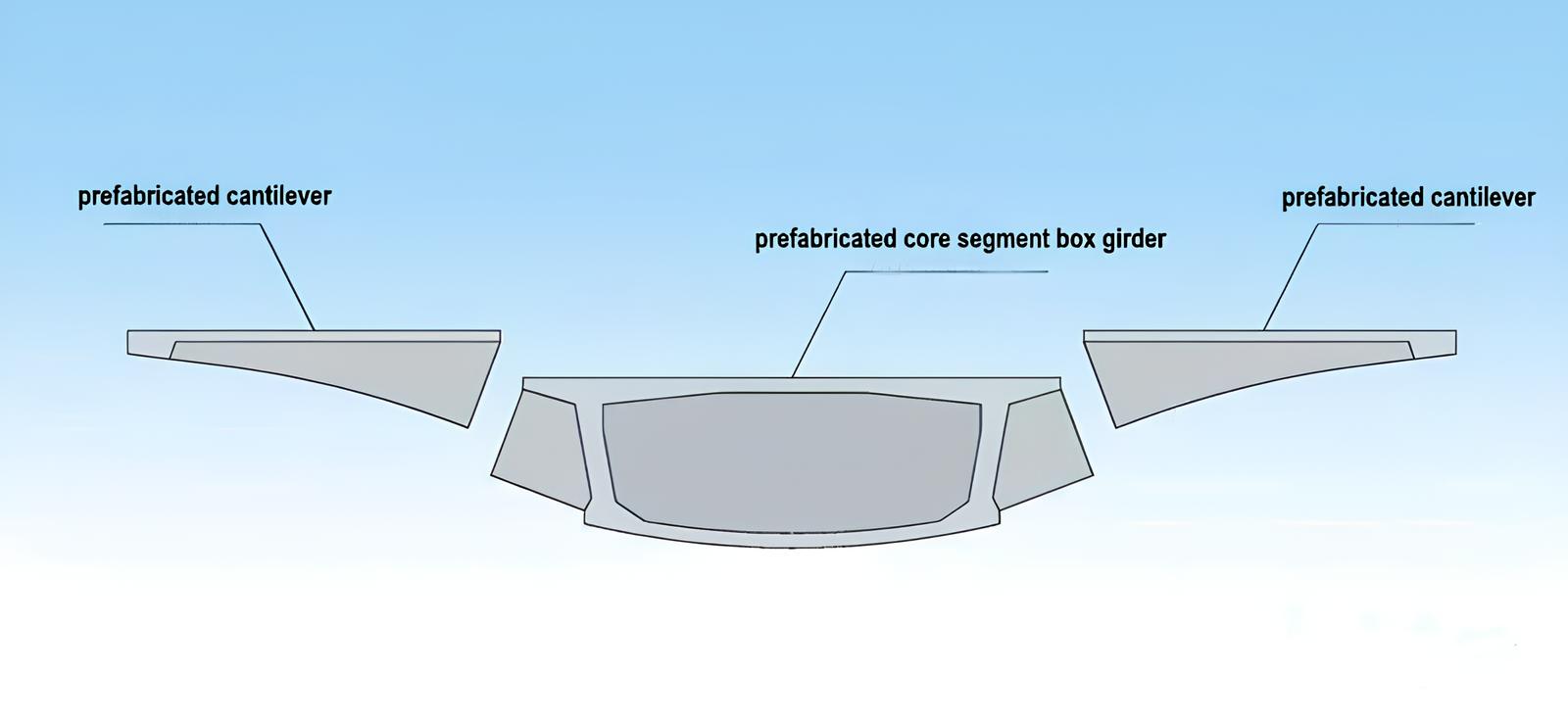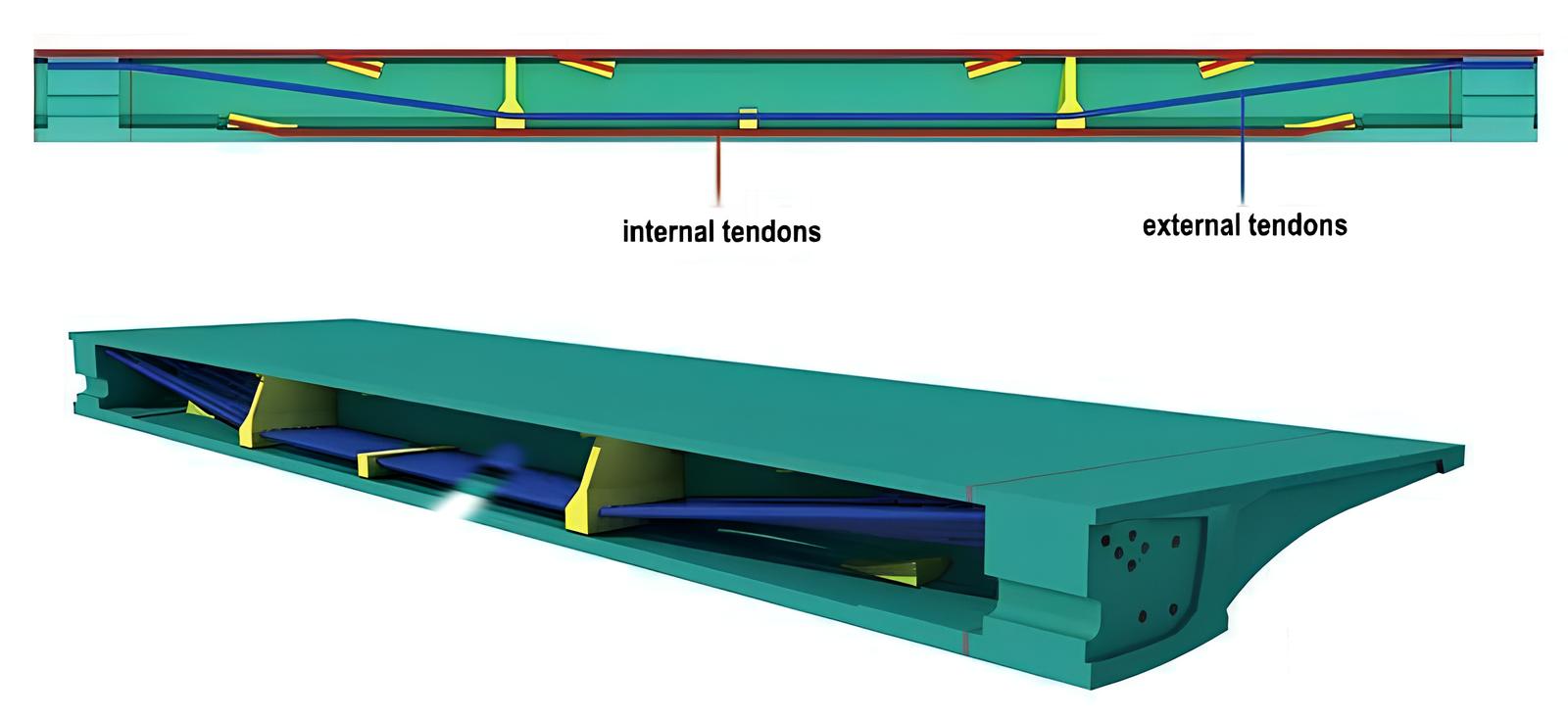The transportation and hoisting challenges of large-size segment box girder limit the application of segmental beam technology in wide-span bridges and are one of the key issues limiting the popularization of prefabrication and assembly technology in the field of municipal bridges. To address the transportation and construction challenges of wide-span segmental beams, this article introduces the concept of a large-cantilever segment prefabricated composite-section spine beam, which decomposing the box girder section of a wide-span and large-cantilever into two parts: the "core segment box girder" and the "prefabricated cantilever". This article researched the reasonable structure, key connections, and prestressing system of this type of bridges.
To reduce the hoisting weight, the segmental beam adopts a composite-section spine beam, and the cross-section is decomposed into the "prefabricated core segment box girder" and the "prefabricated cantilever" in the transverse direction of the bridge. The core segment box girder should be able to bear the construction load of the prefabricated cantilever assembly on the basis of meeting its own stress, and the prefabricated cantilever should consider a structural form that is convenient for construction, highly operable, and has a small impact on the core segment while meeting the overall stress requirements.
Based on the structure's characteristics and requirements, the structural dimensions of the two parts, the "prefabricated core segment box girder" and "prefabricated cantilever" are reasonably arranged, such as the form of web plate setting, the support method between bridge deck slabs, the chamfer of the box chamber, and the size of the cantilever longitudinal beam, to fully utilize the advantages of the large-cantilever composite section in construction and stress. The interface between the core segment and the flange plate should be comprehensively considered in combination with the hoisting feasibility and the stress situation of each part. Figure 1 shows a feasible method for transverse segmentation of the box girder.

Figure 1: Schematic Diagram of the Transverse Segmentation Method for Box Girders
Connection Method
Currently, the longitudinal splicing process for prefabricated segmental beams is relatively mature, but the transverse connection method and connection process between prefabricated components are still lacking theoretical research and engineering practical experience. Aiming at the characteristics of assembling the "prefabricated core box girder" first and then the "prefabricated cantilever," it is necessary to propose a bridge transverse segmented prefabrication and assembly method that has excellent stress performance, simple and reasonable structure, and rapid and convenient construction based on understanding the stress characteristics of this structural system. Among them:
The roof joint between the prefabricated cantilever and the core box girder is tension in the transverse direction of the bridge and is the most critical and unfavorable joint in stress. Therefore, a wet joint is adopted and ordinary reinforcing bars are passed through. To facilitate on-site casting, a concrete bottom form can be reserved at the lower edge of the joint groove during prefabrication.
The rib plate joint between the prefabricated cantilever and the core box girder bears a large vertical shear force and is under compression at the lower edge. A pair of corbels can be set at the lower part of the joint, and the upper half of the joint is connected by a cast-in-place wet joint. Concrete thin plates can be reserved on both sides of the joint as side forms during prefabrication.
The longitudinal joint between adjacent prefabricated cantilevers, due to the rib plate spacing being much smaller than the cantilever length, the bridge deck slab exhibits the characteristics of a one-way slab bending in the longitudinal direction of the bridge under the action of wheel local loads. To improve the prefabrication production efficiency, all cantilever segments should be prefabricated with the same shape. Considering the assembly difficulty of curved sections and superelevation transition sections, a wet joint structure with ordinary reinforcing bars passing through is adopted.
Prestressing System
External prestressing has the advantages of fast construction speed, simple structure, and convenient segment prefabrication. The prestressing tendons can be inspected and replaced during operation, but the prestressing efficiency is relatively low compared to internal prestressing. The tendon position is also farther away from the flange plate than internal prestressing, and internal tendons have high prestressing efficiency and the tendon position is close to the flange plate, but it will increase the difficulty of segment prefabrication. Hence, the longitudinal prestressing tendon adopts a hybrid tendon prestressing system mainly based on external tendons and supplemented by internal prestressing tendons based on construction efficiency (refer to Figure 2).

Figure 2: A Hybrid Tendon Prestressing System Mainly Based on External Tendons
During the construction of the large-cantilever composite-section segmental beam, the core segment structure is formed first and then the cantilever is installed. When erecting the core segment structure, only external tendons are tensioned to improve the erection efficiency. After the core segment is formed, the prefabricated cantilevers are gradually installed, and the internal tendons are tensioned synchronously to ensure that the prestressing effect of the internal tendons can be better diffused to the entire flange plate and ensure the stress performance of the flange plate. The alignment of the internal tendons should be optimized to be the simplest , reducing the prefabrication difficulty and improving standardization .
To Wrap Up
The prefabrication and assembly technology, as the development direction of the bridge industry, has a significant impact on demonstration and popularization. This article explores the large-cantilever prefabricated composite-section spine beam with the "prefabricated core segment box girder" installed first and the "prefabricated cantilever" installed later, overcoming the transportation and construction challenges of large-size segmental beams, improving key design and construction technologies of segmental prefabricated and assembled concrete bridges, and promoting the development of segmental beam prefabrication and assembly technology.

International Department: Room 2211-2212, Tower C of Wanda Plaza, Tongzhou District, Beijing 101118, China.
+86-13021287080
info@boyoun.cn